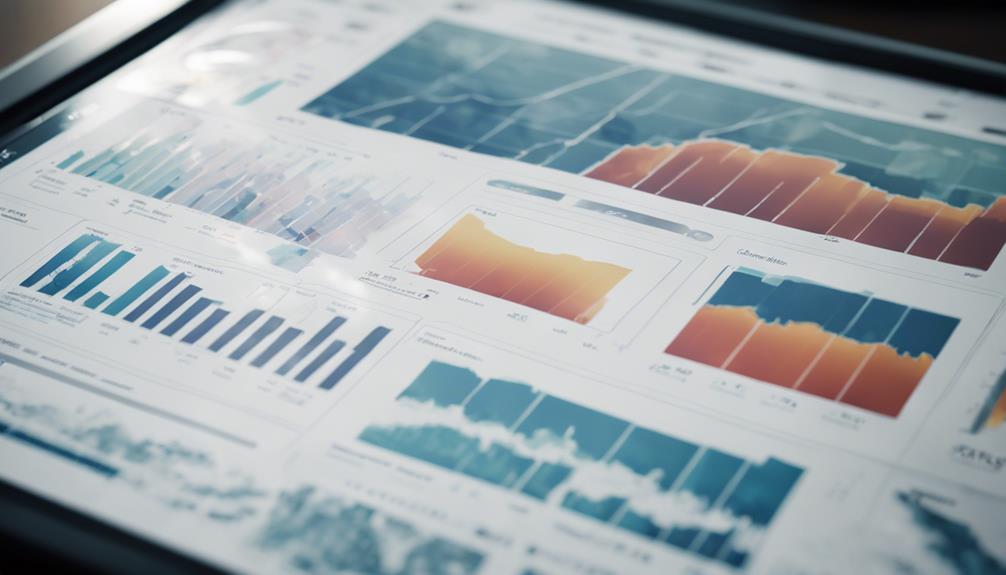Tableau Business Intelligence Review
If you think you've seen all there is to know about business intelligence tools, think again. Tableau's BI platform is a game-changer in the world of data analytics.
With its intuitive interface and powerful capabilities, Tableau has set a new standard for visualizing and interpreting data.
But what sets it apart from the rest? Stay tuned to discover how Tableau's innovative features can revolutionize the way you analyze information and make informed decisions in your organization.
Key Takeaways
- Intuitive and interactive interface for easy data analysis and visualization.
- Seamless data blending from multiple sources for comprehensive insights.
- Scalable platform for efficient handling of large datasets.
- Customizable dashboards tailored to specific business needs for informed decision-making.
Overview of Tableau BI Platform
Tableau BI Platform offers a comprehensive suite of tools for analyzing and visualizing data in a user-friendly interface. When considering user interface design, Tableau excels in providing an intuitive and interactive experience for users of varying technical backgrounds. The platform's drag-and-drop functionality allows for easy creation of visualizations without the need for complex coding or technical expertise.
In terms of technical requirements, Tableau BI Platform is compatible with multiple data sources, including databases, spreadsheets, and cloud services. It supports both Windows and Mac operating systems, catering to a wide range of users. Additionally, Tableau's scalability ensures that it can handle large datasets and complex analytics processes efficiently.
Key Features and Functionality
With a focus on empowering users to analyze data effectively, the key features and functionality of the Tableau BI Platform are designed to streamline the process of visualizing complex datasets. The platform offers a user-friendly interface and interactive dashboards, making data analysis more intuitive and efficient. Here are four key features that enhance the user experience:
- Drag-and-Drop Functionality: Users can easily drag and drop data fields to create visualizations without the need for complex coding or scripting.
- Real-Time Collaboration: Tableau enables real-time collaboration, allowing multiple users to work on the same dashboard simultaneously.
- Data Blending: The platform allows users to blend data from multiple sources seamlessly, providing a comprehensive view for analysis.
- Mobile Accessibility: With Tableau's mobile app, users can access and interact with dashboards on-the-go, ensuring data is available whenever and wherever it's needed.
These features collectively contribute to making Tableau a powerful tool for data analysis and visualization.
Data Visualization Capabilities
Data visualization capabilities within the Tableau BI Platform allow you to transform raw data into insightful visual representations effortlessly. Tableau excels in providing interactive dashboards that help users explore data dynamically. These interactive dashboards enable you to delve deeper into your data, uncovering trends, patterns, and outliers with ease.
The platform's strength lies in its ability to facilitate data exploration through a variety of visualization options. With Tableau, you can create interactive charts, graphs, maps, and more, allowing for a comprehensive understanding of your data. The intuitive drag-and-drop interface makes it simple to build visually appealing representations that convey complex information in a digestible format.
Furthermore, Tableau's data visualization capabilities empower users to customize their dashboards to suit specific needs. Whether you're analyzing sales figures, tracking customer behavior, or monitoring key performance indicators, Tableau's interactive visualizations enhance your data exploration experience, enabling informed decision-making based on clear insights.
Performance and Scalability
Exploring the performance and scalability aspects within the Tableau BI Platform reveals crucial insights into its efficiency and capacity to handle increasing data volumes. When evaluating these components, consider the following:
- Data Integration: Tableau's seamless integration capabilities allow for easy connection to various data sources, enabling users to consolidate information efficiently.
- System Optimization: Through advanced optimization techniques, Tableau enhances query performance and overall system responsiveness, ensuring swift data retrieval and analysis.
- Scalability Features: Tableau's architecture is designed to scale effectively, accommodating growing datasets and user demands without compromising speed or functionality.
- Resource Management: The platform offers robust resource management tools that help allocate computing resources effectively, optimizing performance even during peak usage periods.
In essence, Tableau's focus on data integration and system optimization contributes significantly to its performance and scalability, making it a reliable choice for handling diverse data loads and ensuring smooth operational efficiency.
Impact on Decision-Making
The impact of Tableau Business Intelligence on decision-making processes is profound, revolutionizing how organizations analyze and act on data insights. Tableau provides strategic insights by transforming complex data into interactive visualizations that are easy to comprehend. By presenting data in a visually appealing manner, Tableau enables decision-makers to quickly identify trends, patterns, and outliers that may not be apparent in traditional reports or spreadsheets. This enhanced data visualization capability empowers organizations to make data-driven decisions with confidence.
Moreover, Tableau serves as a powerful tool for decision support by offering real-time analytics and the ability to create customizable dashboards tailored to specific business needs. Decision-makers can easily explore data from different angles, conduct scenario analysis, and simulate potential outcomes to inform strategic choices. This agility in data analysis equips organizations with the agility needed to adapt to changing market conditions swiftly.
Conclusion
Overall, Tableau's business intelligence platform offers a powerful tool for data analysis and visualization.
With an impressive 86% improvement in decision-making speed, Tableau helps organizations make faster and more informed decisions. Its intuitive interface and robust features make it a top choice for businesses looking to harness the power of data to drive success.
Whether you're a small startup or a large enterprise, Tableau's BI platform can help you unlock valuable insights and drive growth.






